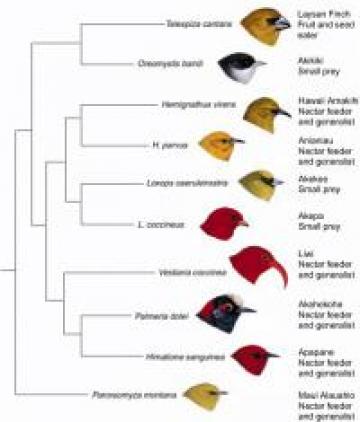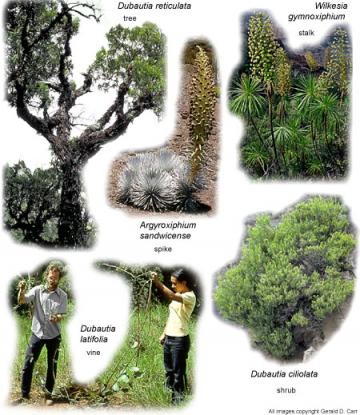Explore Evolution states:
Critics note that the examples of mockingbirds in the Gal pagos and fruit flies in the Hawaiian Islands show only small scale variations in existing traits. Since critics of the argument from biogeography see no evidence of large-scale change, or of a mechanism that can produce the new genes needed to cause such change, they doubt that the biogeographical distribution of animals supports Universal Common Descent.Explore Evolution, p. 77
The issue here of Universal Common Descent is a bit of a red herring. Biogeography is a powerful way to illustrate the power of evolutionary processes, but since all of the parts of the planet have been connected at one point or another, the earliest biogeographic evidence tends to be obscured by subsequent extinction and evolutionary change. Biogeography does reveal the speed with which evolution can operate, and comparing the biogeographic histories of different groups, we can better understand the timing and processes by which various groups evolved. As with the research on mite biogeography discussed earlier, researchers can test predictions of common ancestry by examining overlapping biogeographic patterns, and research on island adaptive radiations provide powerful examples of the power of evolution to generate evolutionary novelties. Explore Evolution claims that these radiations do not demonstrate a mechanism which can "transform one type of animal into a fundamentally different type of animal" (p. 77), but never offers a definition of "fundamentally different." By any reasonable standard, though, island radiations do indeed show exactly such novelty.
 Hawaiian Honeycreepers: A phylogeny of a few of the Hawaiian honeycreepers. These species descended from a single species of finch in the last ten million years. Figure 14 from Steve Olson (2004) Evolution in Hawaii: A Supplement to Teaching About Evolution and the Nature of Science. The National Academies Press:Washington, D.C. (Paintings copyright H. Douglas Pratt, The Hawaiian Honeycreepers: Drepanidinae. Oxford: Oxford University Press, 2003. Diagram adapted from T.J. Givnish and K.J. Sytsma, eds., Molecular Evolution and Adaptive Radiation. Cambridge: Cambridge University Press, 1997.)
Hawaiian Honeycreepers: A phylogeny of a few of the Hawaiian honeycreepers. These species descended from a single species of finch in the last ten million years. Figure 14 from Steve Olson (2004) Evolution in Hawaii: A Supplement to Teaching About Evolution and the Nature of Science. The National Academies Press:Washington, D.C. (Paintings copyright H. Douglas Pratt, The Hawaiian Honeycreepers: Drepanidinae. Oxford: Oxford University Press, 2003. Diagram adapted from T.J. Givnish and K.J. Sytsma, eds., Molecular Evolution and Adaptive Radiation. Cambridge: Cambridge University Press, 1997.) Most of the examples that Explore Evolution discusses are poor examples of the breadth of biogeography, since they are really illustrations of adaptive radiation (and not the most striking examples of that phenomenon, either). For instance, rather than addressing the classic case of the adaptive radiation of Darwin's finches on the Gal pagos, Explore Evolution focuses on the less diverse Gal pagos mockingbirds. Of the 14 species of finches which evolved from an ancestral population blown to the islands several million years ago, the range in sizes is vast, and the ecologies range from vegetarianism to carnivory, from tool-using insect hunters to bills which can crush seeds and to bills that probe into tiny holes to draw out insects. The range of ecologies generated from a small starting population in a few million years is tremendous. Similar ecological diversity evolved among a population of finches which blew onto the Hawaiian islands between 5 and 10 million years ago. Their descendants, known as honeycreepers, show a range of variation in morphology and ecology which falsifies any claim that evolution on islands does not produce fundamental differences. Some authors consider that group to represent a separate family of birds which evolved in a their short time in Hawaii, others regard it as a subfamily within the finches; all agree that their diversity is stunning.
![Cichlid Evolution: [http://evolution.berkeley.edu/evosite/evo101/VIIB1aAdaptiveRadiation.shtml A few of the many mouth morphologies found in Lake Malawi's cichlids]. Based on geological evidence, the nearly 1000 species of cichlid in Lake Malawi evolved in the last few million years, coming to occupy [http://malawicichlids.com/mw01100.htm a range of ecological niches]. Cichlid Evolution: (from http://evolution.berkeley.edu/evosite/evo101/VIIB1aAdaptiveRadiation.shtml) A few of the many mouth morphologies found in Lake Malawi's cichlids]. Based on geological evidence, the nearly 1000 species of cichlid in Lake Malawi evolved in the last few million years, coming to occupy [http://malawicichlids.com/mw01100.htm a range of ecological niches].](/files/images/Cichlids_0.img_assist_custom.gif) Cichlid Evolution: A few of the many mouth morphologies found in Lake Malawi's cichlids. Based on geological evidence, the nearly 1000 species of cichlid in Lake Malawi evolved in the last few million years, coming to occupy a range of ecological niches.
Cichlid Evolution: A few of the many mouth morphologies found in Lake Malawi's cichlids. Based on geological evidence, the nearly 1000 species of cichlid in Lake Malawi evolved in the last few million years, coming to occupy a range of ecological niches. http://evolution.berkeley.edu/evosite/evo101/VIIB1aAdaptiveRadiation.shtm
Similarly, in three lakes of Africa's Rift Valley, a member of a family of fish named cichlids has evolved a range of ecologies and sizes unmatched anywhere else. Those lakes are known to have formed no later than 1.5-2 million years ago, and the hundreds of species of fish in those lakes occupy ecological niches, and exhibit biological forms, unheard of elsewhere. (One species specializes in eating the eyes of other fish.) The range is greater than what you might find at a coral reef, and all from a small number of evolutionary starting points.
In Hawaii, there are about at least a thousand species of flies many still waiting to be described in the genus Drosophila and they all share a common ancestor that separated from the mainland Drosophila tens of millions of years ago. Islands known to be less than 500,000 years old have species which exist only on that island, and which must have evolved in less than half a million years. Those flies represent roughly one third of the members of the genus in the world, and the species found in Hawaii exhibit evolutionary novelties: anatomical traits and behaviors seen nowhere else. This diverse group is not the only adaptive radiation on the islands.
In most of the world, damselfly larvae are aquatic hunters of other invertebrates, breathing through gills on their tails. In Hawaii, some have evolved to live on land, hunting through the leaf litter. In the course of their evolution from aquatic to terrestrial habitats, their gills evolved into air-breathing structures, and representatives of various intermediate stages in this transformation can be found on the islands. Others have adapted to live near the water that collects at the bottom of leaves, but actively avoid being actually soaked in that water, requiring a different set of adaptations. Again, these are structures which are fundamentally different than anything found in other damselflies, and these adaptations have occurred in remarkably short amounts of time.
 Hawaiian Silverswords: A few examples of the diverse morphologies of Hawaiian silverswords. Within 30 species and 3 genera, the group includes trees, shrubs, vines, palm-like stalked plants, aloe-like rosettes, and low-growing ground-cover (not shown). Images by Gerald Carr, University of Hawaii, made available for educational purposes.
Hawaiian Silverswords: A few examples of the diverse morphologies of Hawaiian silverswords. Within 30 species and 3 genera, the group includes trees, shrubs, vines, palm-like stalked plants, aloe-like rosettes, and low-growing ground-cover (not shown). Images by Gerald Carr, University of Hawaii, made available for educational purposes.
Though Explore Evolution constrains itself to discussing animals, adaptive radiations can also be found in the plants of Hawaii. The silverswords, three genera in the sunflower family found in Hawaii have evolved a range of structures, ranging from short plants with spiky leaves to trees, shrubs, vines and low ground-cover. As Futuyma explains, "They vary greatly in the form and anatomy of the leaves and in the size, color and structure of the flowers. In many features their range of variation exceeds that among families of plants, yet almost all of them can be crossed, and the hybrids are often fully fertile. They all appear to have been derived from a single ancestor that colonized the Hawaiian Islands from western America" (Futuyma, 1997, Evolution, Sinauer Associates, Sunderland, MA, p. 118).
The appearance of such diversity from a known starting population demonstrates the incoherence of Explore Evolution's "criticisms". Adaptive radiations have often generated variations exceeding that seen within whole families within a geological flash, yet the authors call these "only small-scale variations in existing traits." By making such a sweeping and imbalanced generalization, Explore Evolution misinforms students about the actual evidence at hand. By making the claims without explaining the basis for them, Explore Evolution makes it impossible for students to explore these ideas in any additional depth, once again hindering inquiry, rather than encouraging and supporting true scientific investigation. If such new structures can be generated in the space of a few milllion years, it's not hard at all to envision the same processes producing the diversity of all life in the space of billions of years.
